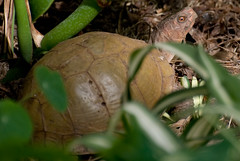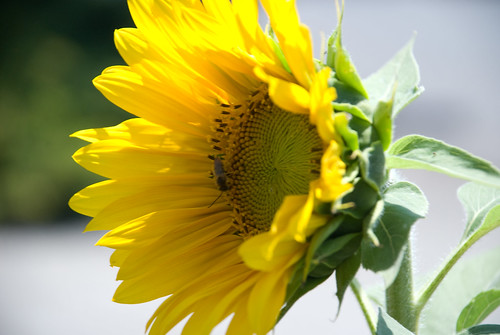The yellow on his head, shoulders, and aft-end is not pollen. The orange saddlebags on his hind legs is pollen. But, as I said, he's the biggest and most obvious of the pollinators out there working over all my flowers.
Of all the visitors, there are a few different bees (including this guy and honeybees), a variety of flies (who seem to be mostly just shopping), and a LOT of different wasps. While some of the species of wasps are nearly as large as Mr. Bee (above), most of them are much smaller. One is as tiny as an ant! Some are brighter yellow and highlighted with black. Some are such a pale straw color that they seem almost transparent. Besides being all different sizes, they come in a wide variety of shapes, though many of the wasps are sort of in the generic "wasp shape" with the skinny waist.
Here's another example of a pollinator. This one is working over a sunflower, though I could tell you whether it's a wasp or bee, let alone what species!
The point is that all of our plants need a wide variety of insects for effective pollination. Different plants need different pollinators. Some plants require very specific pollinators. Approximately one third of our agricultural crops in the US require sufficient pollinators to be able to produce all that... produce.
So, what do you think happens to all of those pollinators when people spray insecticide around indiscriminately? In the past, I've had neighbors with beds of prized roses who would completely freak out whenever he saw an aphid. Out would come the pump sprayer and the gas mask and he'd be out there spraying in a breeze strong enough to cause his spray to drift all the way across my yard! (What the hell! He's gassing his aphids, my pollinators, and ME while he's wearing a respirator!)
If you've been watching the news, maybe you've heard of Colony Collapse Disorder. This is a not-as-yet-understood phenomenon where the entire population of worker bees from a colony of honeybees will simply disappear. CCD has been on the rise in the US in recent years and the growers are worried that there won't be enough honeybees to pollinate all the crops.
Well, that's where the native pollinators come in! A number of vineyards in Napa (and other) counties have been striving to be more "organic." (No discussions here as to what "organic" means other than to say that one intent is to rely less on artificial/chemical means to grow healthy products.)
Anyway, one of the things they are trying is the use of interplanting the rows of grape vines with native flowers and surrounding each of the fields with hedgerows of native trees. (Frequently, these hedgerows can be planted where cannot be reasonably grown and harvested.) The introduction of the native trees and forbs invites all sorts of insects to come for a visit and to live in their natural habitat. The idea is that, of all the insects that come to live in the trees, many will be pollinators. But the extra-added bonus is that many of the insects will also be what gardeners and farmers call "beneficial insects." These are insects that eat (or otherwise parasitize) the insects that cause crop damage.
One popular example of a beneficial insect is the Lady Bug. Yes, Lady Bugs are cute as the dickens. But Lady Bugs provide the VERY cool service of sucking the life out of the aphids that suck the life out of our crops (and rose bushes)! So, that Fine Neighbor of mine, instead of gassing the aphids, pollinators, and ME out of existence, could have gone to a reputable dealer and gotten some Lady Bugs to take care of his aphid infestation. (In reality, he didn't have an infestation. He had a couple of aphids.)
Some wasps make sure their babies are going to have food by laying their eggs on (or in) crop-munching larvae (caterpillars). When the eggs hatch, the babies eat the larva. Tomato-munching larva... all gone.
By the way, the "organic" vintners are finding great success with the interplanting. Pest insects are being kept in check without spraying and the vines are being quite effectively pollinated without having to rent portable beehives.
If you note that insecticides won't kill each-and-every pest that you spray for -- while killing most of the beneficial insects and pollinators indiscriminately -- and reconcile yourself to the occasional pest and a teeny bit of crop damage, you might find yourself quite pleased with the results of using more natural methods of pest control.
Ooh! And the extra-added bonus of having all sorts of insects around, keeping each other in check? You will have written a dinner invitation to all manner of birdies who will come by to eat whatever insects they can find!












No comments:
Post a Comment